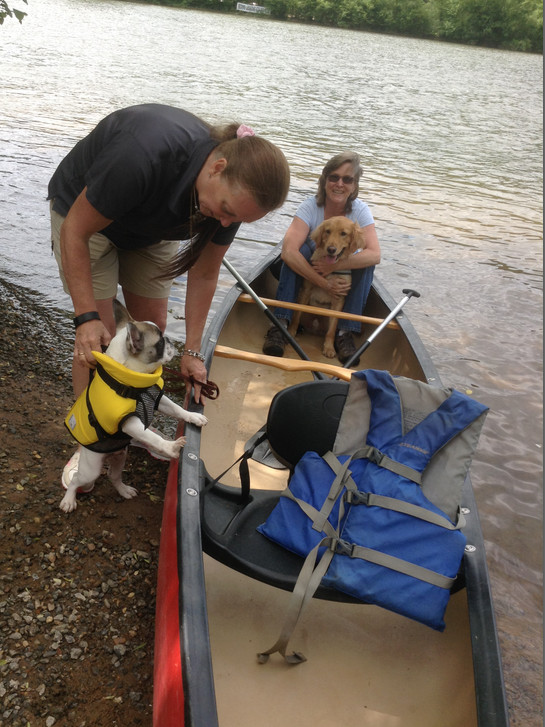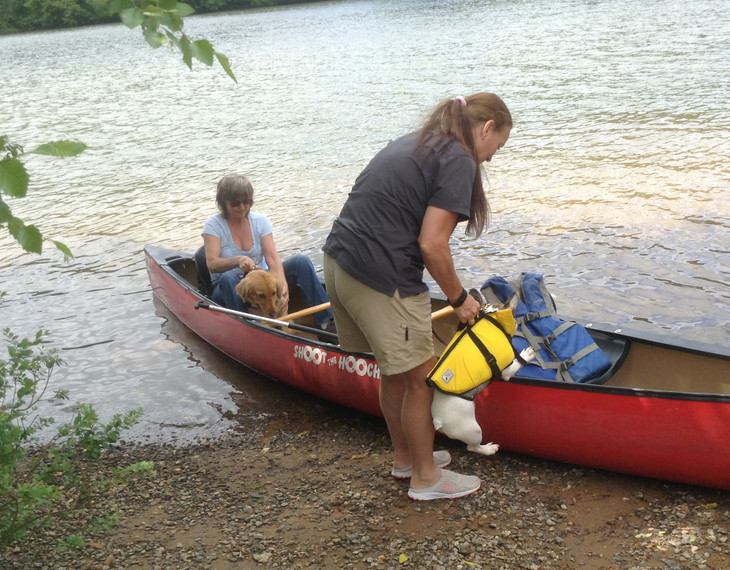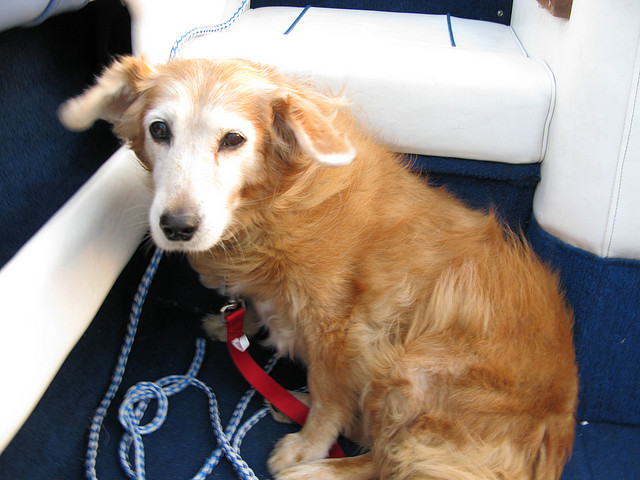
Taking a dog out on the water can be a ton of fun for both you and the dog. However, if your dog has never been on a boat, kayak, raft, canoe, etc., it can take some getting used to. In fact, some dogs might be scared or nervous at first –as the motion can cause them concern and so can all that water.
Kimberly Brenowitz is a Master Dog Trainer, certified with EARS (United Animal Nations) now known as Red Rovers which brings animals from crisis to care, Pet Partners certified with her Service Dog Simon, CERT qualified (Community Emergency Response Team Cobb County, GA) for disaster relief, and is also certified in animal first aid with the American Red Cross. She is a member of APTA for dog trainers and also a member of the Humane Education Association. In addition, a member of: International Association of Assistance Dog Partners and Association of Pet Dog Trainers. Through Animals Deserve Better, Inc., Brenowitz has helped to rescue over 3,000 animals. (www.animalsdeservebetter.org)
In addition to all her amazing accomplishments, Brenowitz teaches water training classes for people that want to take their dogs out on the water. This made her the perfect person for us to interview about getting a dog used to watercraft.
If your dog is really nervous/scared of the boat should you force them on, thinking they will “get over it”?
KB: If you force your dog then the likely hood is that you will cause more harm than good. The best thing to do is to get your dog used to a boat first. Keep your dog’s first outing short so he can adjust to the boats movement. Take a few short trips before going out for the day – boating with some dogs can take a little longer than others. Keep it all positive and praise the dog only when he is doing good, don’t praise for a behavior that you do not want.
What is the best way to get a dog used to going on a boat?
KB: Let your dog get acquainted with the boat before taking him out on the water. Bring him to visit the boat while it’s on a trailer or at the dock so he can get used to his surroundings in a safe, secure environment, including turning on the boat engine so he gets used to the sound. Remember to invest in a life vest for your dog and let him get used to wearing it before going on the boat. Praise him for getting on and off the boat when asked. You can also get him used to being hooked up on the boat this is where your obedience teaching of sit, down and stay come in handy so that he is safe and cannot fall overboard or get hurt.

What about a smaller, less stable water craft such as a kayak, raft, or inflatable boat?
KB: If you are taking your dog on a small boat, such as a canoe, kayak or raft, it is best to introduce him to it on dry land first. Sit in the boat with a treat in your hand and call him. When he comes to you, reward him with the treat, we use praise. Stand up and rock the boat just a little bit, praise him again for staying in the boat. Do this for a few days and increase the time each day that you are in the boat and continue to praise him. Alternate keeping the boat still with providing some rocking motion. If your dog wants to get out, let him. Play a fun game together and try again another time. If you need to, you can always throw his favorite ball or treat in the boat. Never force him to stay in the boat. The idea is to build up a positive association towards the boat.

What signs should the owner look for that shows their dog may not be comfortable?
KB: Symptoms your dog may have include:
- Panting
- Drooling
- Trembling
- Swallowing
- Restlessness
- Lip licking
- Retching
- Vomiting
- Anxiety
Nauseous dogs may show signs of anxiety, stress, vocalization, nervousness, hyperactivity, and even have bowel movements or urination during travel.
Do dogs get sea sick? If so, do you have suggestions for remedies?
KB: The first time they are out on a boat they can also get seasick, if seasickness becomes severe, ask your veterinarian about possible medication for future outings. Dogs get motion sickness when the body, the inner ear, and the eyes send conflicting signals to the brain causing nausea and dizziness. Motion sickness is more common in puppies, and many dogs outgrow it in part because they enjoy being out in the boat.

If you are out on the water and your dog is hanging his head over the rail not in fun but in sickness one of the motion-sickness medications people take could help. Please talk to your veterinarian first, because not all over-the-counter medications are safe for pets (some, in fact, are lethal), and you need to know if the drug is right for your dog and what the proper dosage will be. For more severe or frequent cases, your veterinarian can provide a prescription that will help your dog. These include:
- Dramamine
- Benadryl Acepromazine (Rx)
The latter is a longtime favorite of many veterinarians that not only helps calm anxious dogs, but also helps reduce nausea and vomiting. Care is recommended when using Acepromazine, as some dogs are very sensitive to the drug and may become excessively sedate. Other dogs may become hyperactive, and in rare cases have seizures on this medication. A safer alternative for dogs is the prescription drug Cerenia. This powerful anti-nausea medication has been approved for dogs of all ages, and is very helpful in decreasing nausea and vomiting from motion sickness.
If your dog gets motion sickness on a limited bases and you are on salt water, it could be because he is drinking the water. Thirsty dogs will drink salt water (or take it in while swimming). If you are not paying attention, the first time you notice there’s a problem may be when your dog throws up. If the problem might be salt water, the solution is to make sure your dog is offered plenty of cool fresh water while you’re out on the boat so that he’s never tempted to drink the salty stuff.
Homeopathic remedies that have a great reputation for use in motion sickness in dogs include cocculus and aconitum. Giving one of these remedies in 30c potency 15 minutes before travel and then up to two more times every 30 to 60 minutes as needed is recommended to reduce nausea, vomiting, and anxiety during travel. Ginger has a long history of medicinal use in traditional Chinese medicine and Ayurvedic (Indian) medicine. Herbal remedies offer a mild, short-acting sedative action, and the ones mentioned here are calming to the stomach or specifically anti-emetic. Many herbs, however, are not pleasing to a dog’s palate. You can use capsules or non-alcoholic tinctures or pour a mild tea over your dog’s favorite treats.
